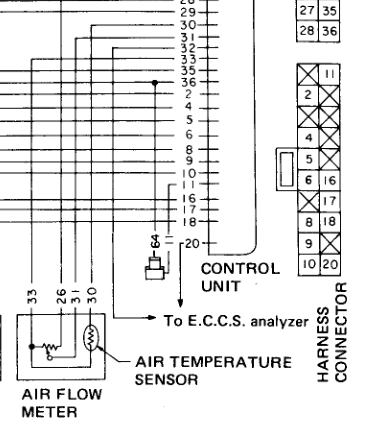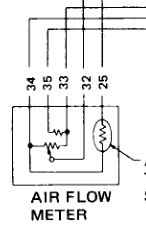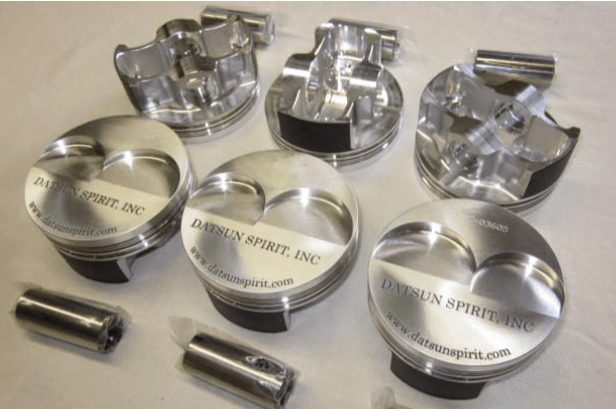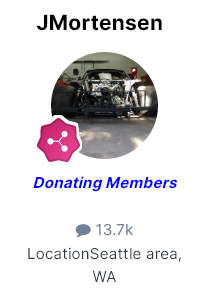
NewZed
Members-
Posts
6698 -
Joined
-
Last visited
-
Days Won
72
Content Type
Profiles
Forums
Blogs
Events
Gallery
Downloads
Store
Everything posted by NewZed
-
Not an expert but what do you mean when you say "power"? For HP to stay flat torque would have to drop off. An image of the dyno curve might be helpful Looks like you're focused on air flow through the intake side with your thoughts about the cam. Have you thought about rigging up a temporary 3" muffler system or just run an open downpipe on a dyno run just to knock out the exhaust side as a cause. Simple easy test, might show something. You mentioned the pipe size but nothing about the muffler itself. Also, where are you measuring boost from? The plenum? Again, not an expert, but aren't the stock runners kind of small?
-
That's not a booster problem, it's a master cylinder problem. You need a new master cylinder, it's leaking internally. If you're lucky it hasn't leaked externally, in to the booster, yet.
-
[help/opinions needed] Oil pressure won't go past 40psi.
NewZed replied to Jazz86's topic in Nissan L6 Forum
Congratulations on finding the source. I'm not really clear on what your picture is showing or how the cooler is supposed to work. But, regardless, if you keep working back to the basic principles on a problem eventually you have to find the solution, as you did. Good luck. -
The Walbro 255 is good for over 600 horsepower. I think that most people choose it without really doing any calculations of what they need. Also, if the fuel lines are too small the pump will work harder and make more noise. The original L28 pump pushes about 30 GPH or 110 LPH. The fuel line size would have been calculated for that flow rate. No offense intended, it's just one of those things I've noticed. People buy the 255 then notice the noise.
-
Early Q45 Rear Wheel Bearings
NewZed replied to socorob's topic in Brakes, Wheels, Suspension and Chassis
This site works well sometimes. You'll have to figure out the various tabs. Many choices of vehicle or cross-reference. http://www.showmetheparts.com/timken/ Edit - Tried a few, it didn't find anything. If you live in an area with some industry you probably have a bearing shop nearby. They can find almost anything. I used to go to these guys. They'd take some measurements and go to the books. https://mcguirebearing.com/locations/#portland -
The description starts at post #2 and the discussion continues for many more posts after.
-
Using a swap kit or just fabricating as you go?
-
The two switches on top of the steering column are the ones that have problems. You're right it doesn't matter much which side you choose as long as you take the load off of the switch. I did the headlights and the running lights on my 76. The headlights were easy, right by the fuse box, but I had a hard time finding easy access to the supply wire for the running lights. Seems like you're thinking right. Study the circuits though to make sure you're not missing something. Not sure what year you're working on. Nissan changed things up over the model years. 1976 headlights.
-
[help/opinions needed] Oil pressure won't go past 40psi.
NewZed replied to Jazz86's topic in Nissan L6 Forum
You don't show the oil cooler in your drawing. A follow-up on why a gauge on the filter housing might tell something. After it leaves the filter it hits the small main oil galle(r)y passage. Then it splits up and down. You will have maximum possible pump pressure in the oil filter. If you get the same number in the filter as at the port then you'll know that something before the filter is the problem. If after, then you can stop looking at the pump. Don't forget also the Bernoulli and Venturi principles. If you have some sort of obstruction in front of the oil pressure port the moving oil can actually cause a pressure drop at the port opening. Which makes me think that maybe your fixture at the gauge port is projecting in to the oil galle(r)y channel. https://jacobsanalytics.com/eductors/venturi-eductors/#:~:text=Basically the Venturi vacuum pump,partial vacuum in the process. -
[help/opinions needed] Oil pressure won't go past 40psi.
NewZed replied to Jazz86's topic in Nissan L6 Forum
jonbill's suggestion of a blockage in a passage seems reasonable. It would have to be before the gauge port. And moveable. Something that opens after sitting then gets pushed to block flow. A gauge on the oil filter might tell something. Here's an example, not sure what measurements you would need. https://www.amazon.com/GlowShift-Filter-Sandwich-Adapter-Thread/dp/B007SXGAZQ -
Funny that I posted the EFI AFM drawing instead of the ECCS drawing, but the EFI numbers match your picture and the ECCS numbers don't. I got the drawings from the 1982 FSM Engine Fuel and Emissions chapter. Page 80 and page 96. I posted the ECCS wiring below. Different numbers, but four pins. Either way though the pins run through a resistor, the AFM carbon trace, so there should be no chance of an over-current condition. Could be that a diode circuit got reversed in the ECU. (Edit - or a capacitor. One of my first electrical circuit experiences was connecting a radio condenser up backwards and having it blow up in my face. Pretty sure my father was messing with me...) I'm not deep on electronics. Looks like you got your power supply and return circuits reversed. No idea what that would cause. The ECU's were pretty primitive. It's too late (in the evening) for me to logic out what's what but the air temperature sensor is on the 33/34 circuit. So 33 and 34 is probably ground. Anyway, if it was mine I'd run through all of the tests again. And, if possible borrow a turbo ECU to try. Seems difficult though. @cgsheen knows the ECCS system pretty well. He might have some thoughts.
-
Can you show the actual pins on the AFM? Might be a clue. Also, more detail on how it runs might help. Might be something simple like something else you did at the same time but might not be correct. Like a temperature sensor. The pin numbers should be molded in to the connector on the AFM.
-
[help/opinions needed] Oil pressure won't go past 40psi.
NewZed replied to Jazz86's topic in Nissan L6 Forum
What is cold pressure? What oil? Not clear what this, below, would accomplish. It forces the oil to always pass through the filter. The filter bypass is meant to guarantee oil supply to the galle(r)y, even if the filter blocks flow. Pressure comes from forcing the oil through all of the various bearing gaps after the filter. Are you sure that this was done after the problem and not before? -
[help/opinions needed] Oil pressure won't go past 40psi.
NewZed replied to Jazz86's topic in Nissan L6 Forum
How about a new spring in the pump? Example - https://www.thezstore.com/product/3995/high-pressure-oil-pump-springs-70-83-zzx Here is an old thread about the topic. I didn't read through it, but the guys in it are typically well-informed. -
A full set? Every fork? You might try putting a Wanted ad on Classiczcars.com. There a few guys over there that sell used parts.
-
Skirt coating stuff. There's a whole industry. https://patterson-elite.com/piston-skirt-coating/ https://www.rosspistons.com/piston-coatings/ https://auto.jepistons.com/blog/je-s-patented-perfect-skirt-coating-is-a-breakthrough-in-piston-technology
-
Imagine how these tiny skirts would run. I think that they are coated to help with what you're seeing. https://www.datsunspirit.com/product-page/super-lightweight-forged-pistons
-
Edit - sorry I probably didn't read what you were saying correctly. You meant that the oil film was breaking down and the skirts were scuffing the bore. Anyway, the following still applies. Short/small skirts have drawbacks. Good luck. Not sure why the focus is on the skirt contacting the bore. Piston skirts do contact the bore during normal piston movement. The reason for the small skirts is to reduce friction for better performance. But it also allows more cocking of the piston in the bore so the wear patterns change. Piston skirt design is a specific area of study. Lots of stuff out there. Performance improvements tend to have more expensive side effects. You can build for longevity or performance, but those two things tend to conflict. https://everythingaboutboats.org/piston-skirt-length/#:~:text=There is a direct relationship,rings and the cylinder bores. https://auto.jepistons.com/blog/maximizing-horsepower-with-piston-skirt-shaping https://www.sae.org/publications/technical-papers/content/970839/
-
Profile says I am an "Apprentice" but I have over 2000 posts
NewZed replied to Miles's topic in Site Support
-
Saw the same reply three times. So, it is possible. Not sure you understood my point about the subtitle/name/label change. For whatever reason, after a name change it seems the forum software re-labels people as Newbies. I don't really get much from the labels anyway. Moderators can label you, or the forum software has default labels. I am, apparently, a "Members" now. Plural. What does that mean?
-
Is it possible that you were trying to respond to an FAQ post? The FAQ reply problem has never been resolved. Your post count still shows. I know that after I asked to have my subtitle changed from "Clandestine Moderator" ('cuase people were thinking I was a real moderator) that my new subtitle was Newbie. Weren't you a real moderator for a while? Maybe it's just the subtitle change.
-
cranks, but no start/ignition (video)
NewZed replied to SoFlaZ06's topic in S30 Series - 240z, 260z, 280z
I assume that you mean the inline resistor on the line from the ignition coil to the tachometer. I don't know what "POXY resistor" means. It's in the wiring harness by the fuse panel under the glovebox. You can see the lump under the tape. It is rarely a problem. Shouldn't affect starting.








